Study of the effect of organic shell on the leaching of protective compositions from wood protected from fire
DOI:
https://doi.org/10.32347/2707-501x.2024.54(1).128-138Keywords:
wood, fire protection, organic shell, flame retardant, wood modification, leachingAbstract
Today, there are various ways to fireproof wood. When wood is moistened, flame-retardants dissolve in a humid environment and gradually wash out to the surface, after which the fire protection effect decreases over time. Acid-based products do not have a significant leaching problem due to changes in wood moisture, but by penetrating deep into the wood structure and interacting with cellulose, they reduce strength characteristics. Another method is to apply a coating based on organic or inorganic binders to the wood surface. Products based on organic binders have increased smoke generation and toxic substances, so their use is dangerous. Therefore, an analysis of protective materials for wooden building structures was carried out and the need to develop reliable methods for studying the leaching of flame-retardants necessary for the creation of new types of fire protection materials was established. There is a need to determine the conditions for the formation of a barrier to the leaching of flame-retardants and to establish a mechanism for inhibiting the transfer of moisture to the material. In this regard, a mathematical model of the process of leaching protective substances from wood after its impregnation with flame-retardants when using a polymeric shell made of organic material as a coating was developed, which allows us to evaluate the effectiveness of the polymeric shell by the amount of water absorbed. The results of calculating the weight gain of the sample during exposure to water indicate an ambiguous effect of the nature of the protection on water absorption. In particular, this implies the availability of data sufficient for the qualitative process of inhibiting moisture diffusion and identifying, on its basis, the time point from which the decrease in coating efficiency begins. Thus, there is reason to believe that it is possible to regulate the processes of wood protection in a targeted manner by using polymer coatings that can form a protective layer on the surface of the material that inhibits the rate of water absorption.
References
Tsapko Yu., Tsapko А., Bondarenko O. Establishment of heat-exchange process regularities at inflammation of reed samples. Eastern-European Journal Enterprise Technologies. 2019. Vol. 1. No 10 (97). Р. 36-42. DOI: 10.15587/1729-4061.2019.156644.
Цапко Ю.В., Ломага В.В., Цапко О.Ю. Вогнезахист деревини органо-неорганічними композиціями: монографія. Київ: ФОП Ямчинський О.В. 2023. 160 с.
Núñez-Retana V.D., González-Tagle M.A., González-Rodríguez H., Yáñez-Díaz M.I., Himmelsbach W. Prominent wood protection methods. Revista Mexicana de Ciencias Forestales. 2024. Vol. 15 (84). Р. 155-175. https://doi.org/10.29298/rmcf.v15i84.1441
Atanasova K., Angelski D. Water Permeability and Adhesion Strength of Bio-based Coating Applied on Wood. Drvna Industrija. 2024. Vol. 75 (1). Р. 43-48. https://doi.org/10.5552/drvind.2024.0118
Setswalo K., Oladijo O.P., Namoshe M., et al. The Water Absorption and Thermal Properties of Green Pterocarpus Angolensis (Mukwa) – Polylactide Composites. Journal of Natural Fibers. 2023. Vol. 20 (1). Р. 12-29. https://doi.org/10.1080/15440478.2022.2124217
Iejavs J., Ruļuks O., Laiveniece L., Liše S., Spulle U. The efficiency of different wood coatings against water surface absorption. Rural Sustainability Research. 2021. Vol. 45 (340). Р. 28-37. DOI: 10.2478/plua-2021-0005
Perdoch W., Depczyńska E., Tomkowiak K,, Kurczak M., Mazela B. The Impact of Vinylotrimethoxysilane-modified Linseed Oil on Selected Properties of Impregnated Wood. Forests. 2022, 13(8), 1265. https://doi.org/10.3390/f13081265.
Zhang Z., Ye D., Li Y., Yang Y., Liao Y. Enhancing weatherability and mechanical properties of tung oil wood finishes through natural rubber modification via the Diels-Alder reaction. International Journal of Biological Macromolecules. 2024, 272(2), 132602. DOI: 10.1016/j.ijbiomac.2024.132602
Altay Ç., Babahan-Bircan İ., Toker H. et al. Physical, mechanical, and surface properties of Oriental beech coated with bio-based epoxide nano-coatings after weathering. Journal of Coatings Technology and Research. 2024, 21, 2023-2034.
Wang L., Ge H., Wang J. Model validation and 2-D hygrothermal simulations of wetting and drying behavior of cross-laminated timber. Journal of Building Physics. 2023. Vol. 46 (6). Р. 737-761. DOI: 10.1177/17442591231165987
Soytürk E.E., Kartal S.N., Onses M.S., Celik N. Preliminary evaluation of polydimethylsiloxane and hydrophobic silica nanoparticles to improve water repellency and boron leachability in wood. European Journal of Wood and Wood Products. 2023. Vol. 81 (1). Р. 89-98. DOI: 10.1007/s00107-022-01883-7
Ding Z., Lin W., Yang W., Chen H., Zhang X. A Silicone Resin Coating with Water-Repellency and Anti-Fouling Properties for Wood Protection. Polymers. 2022. Vol. 14 (15):3062. DOI: 10.3390/polym14153062.
Miklečić J., Jirouš-Rajković V. Effectiveness of finishes in protecting wood from liquid water and water vapor. Journal of Building Engineering. 2021, 43, 102621. DOI: 10.1016/j.jobe.2021.102621
Yue D., Lin S., Cao M., Lin W., Zhang X. Fabrication of transparent and durable superhydrophobic polysiloxane / SiO2 coating on the wood surface. Cellulose. 2021. Vol. 28 (6). Р. 3745-3758. DOI: 10.1007/s10570-021-03758-1
Downloads
Published
How to Cite
Issue
Section
License

This work is licensed under a Creative Commons Attribution 4.0 International License.
Authors who publish with this journal agree to the following terms:
- Authors retain copyright and grant the journal right of first publication with the work simultaneously licensed under a Creative Commons Attribution License that allows others to share the work with an acknowledgement of the work's authorship and initial publication in this journal.
- Authors are able to enter into separate, additional contractual arrangements for the non-exclusive distribution of the journal's published version of the work (e.g., post it to an institutional repository or publish it in a book), with an acknowledgement of its initial publication in this journal.
- Authors are permitted and encouraged to post their work online (e.g., in institutional repositories or on their website) prior to and during the submission process, as it can lead to productive exchanges, as well as earlier and greater citation of published work (See The Effect of Open Access).

